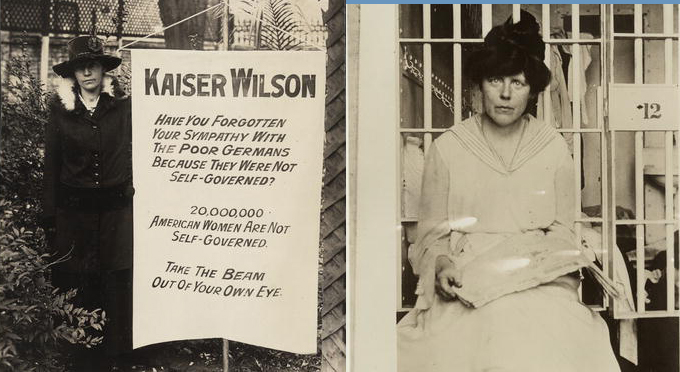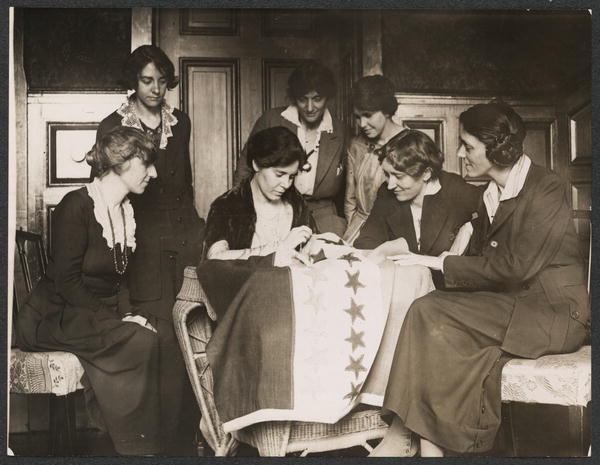National Woman's Party History and Geography
 National Woman's Party civil disobediance during World War I led to imprisonment and hunger strikes (Library of Congress)
National Woman's Party civil disobediance during World War I led to imprisonment and hunger strikes (Library of Congress)
The accomplishments of the National Woman's Party are legendary. In just seven years, the NWP achieved what most thought impossible, securing an amendment to the US Constitution guaranteeing women the right to vote. Social movements ever since have learned from the tactics and determination of the NWP.
Launched in 1913 as the Congressional Union for Woman Suffrage, the organization turned away from the strategy of the venerable National American Woman's Suffrage Association (NAWSA) which worked state by state to win voting rights, concentrating instead on the seemingly impossible prize of a constitutional amendment. Deploying militant tactics that alienated many suffrage supporters, the CU adopted a strategy of attacking the ruling Democratic Party and President Woodrow Wilson, holding both responsible for congressional inaction on the suffrage bill. Shortly after reorganizing as the National Woman's Party in 1916, activists embarked on a campaign of civil disobedience that introduced tactics that many social movements would later emulate.
World War I raised the stakes. Braving mob attacks and federal authorities determined to suppress wartime protests, NWP activists endured violence and imprisonment, fighting back with hunger strikes and more disobediance. Results became apparent in 1918. First President Wilson came around, then the House of Representatives. It took another year to get the Susan B. Anthony Amendment through the Senate and a second year to persuade enough state legislatures to ratify. On August 18, 1920, the amendment became part of the Constitution.
The NWP celebrated but was not finished. In 1923, they proposed the Equal Rights Amendment and have spent the better part of a century fighting to make it law.
In this section we explore the history and geography of this remarkable social movement. Below are links to (1) a detailed year-by-year history of the organizations activities 1913-1922.
(2) An illustrated Story Map that provides a timeline of key campaigns. (3) a set of maps for Washington DC where much of the campaign was concentrated; (4) a filterable database of nearly 400 activities outside of Washington DC.
|
This illustrated essay chronicles the actions and accomplishments of this remarkable social movement while displaying more than 50 photographs from the "Women of Protest: Photographs from the Records of the National Woman's Party" (Library of Congress).
|
|
This Story Map scrolls through a quick history of the NWP mapping locations of key demonstrations and other actions. Includes almost two dozen historic photographs. .
|
|
From the beginning, the NWP focused tightly on Washington DC. It's first headquarters was some distance from the Capitol, but soon the NWP moved closer, a mere block from the White House. These maps and timeline show the locations of picket lines, arrests, and meetings in the nation's capital.
|
|
This map and timeline database show more than 400 NWP actions outside of Washington DC where the organization was headquartered and where it focused its efforts. Filter by year and state. |
The National Woman's Party section began as a collaborative class project in History 105 and History 353 at the University of Washington in 2016. Samantha Mayes, Alyssa Bell, Cassondra St. Cyr, Alyssa Crawford, Zach Thomas, Samantha Han, Sara Parolin, Monica Keosombath, Hannah Dinielli, Paige Peacock, McKenna Donahue, Anne Peterson , Taylor Franks, Marina Hodgkin, Halle McClain read issues of the Suffragist and searched ProQuest newspaper databases for articles about the activities of the National Woman's Party from 1913-1922, entering information into a database that provides the basis for the accompanying maps. They also wrote reports that detailed some of the key issues and actions of the pivotal civil rights organization. Selections from those reports are compiled into National Woman's Party: a year-by-year history 1913-1922. Katie Anastas is project editor.
All photos on these pages are from the Library of Congress collection: Women of Protest: Photographs from the Records of the National Woman's Party.
|

 National Woman's Party civil disobediance during World War I led to imprisonment and hunger strikes (Library of Congress)
National Woman's Party civil disobediance during World War I led to imprisonment and hunger strikes (Library of Congress) 